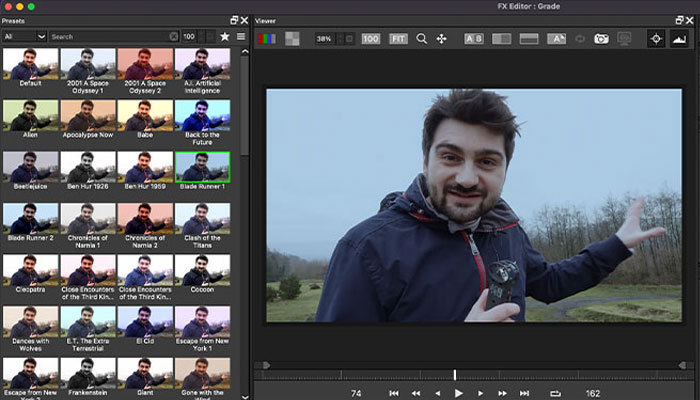Today on Art of the Cut, we discuss the documentary, Fire of Love with the editors of the film, Erin Casper and Jocelyne Chaput. The film won the Jonathan Oppenheim Editing Award. It won Outstanding Directorial Achievement in Documentary. The film has been nominated for a BAFTA and an Oscar, and it's been nominated for an ACE Eddie for Best Edited Documentary.
Jocelyne’s credits include the documentaries People of a Feather, Fractured Land, Starlight & other Sounds: the music of Alexina Louie, and Power of the River.
Erin’s credits include the documentaries Risk, The Seer and the Unseen, American Promise, and Roll Red Roll.
Oscar BAFTA and ACE Eddie nominated documentary Fire of Love with the editors of the film Erin Casper and Jocelyne Chaput
This interview is also available to listen to on Anchor, Spotify, Apple Podcasts and many others.
Thank you so much for joining me, Jocelyne and Erin. I want to start off with congratulations, of course, on your ACE Eddie nomination and, I'm sure a bunch of other nominations. Let’s talk about starting a documentary in the freezing snow. It's called Fire of Love and it’s a volcano documentary, but you start with a bunch of snow.CASPER: We really wanted to throw a wrench in this.
CHAPUT: I think your reaction is exactly why we did it. Let's go somewhere cold. Let's immediately pique peoples' curiosity and serve them something that's unexpected. But it also suits the tone we're setting.
With a question like this, there's a practical answer and then there's a philosophical answer. So the practical answer is: that shot of them in Iceland was one of the rare shoots where they had a camera person with them. It was one of those rare shoots where we actually had images or clips of the two of them together. Most of their expeditions, it was only the two of them and one of them was always behind the camera. It was rare to have that kind of coverage of the two of them. The coldness just seemed so counterintuitive and it's not what you expect. There's something about it that was really appealing.
One of the practical reasons that this footage would be good to have at the beginning was to establish Katia and Maurice, our two characters. One of our references there is actually the beginning of the book, “Frankenstein,” which starts in a snowstorm. That came to mind for us as a reference. It's a very subtle reference, but for us it was the mood of not being sure if this is madness or not. What are they doing in this blizzard and where are they? They seem deep in the heart of this frigid landscape. Are they okay? I think it just set the tone of this mad pursuit. But then when you actually see them and their faces, you see the love in their faces when they finally glimpsed the volcano. It was this play on the frigid world, but the love that starts to thaw the film and set the stage for hotter climates to come.
CASPER: It says a lot about who they are. There's a lot of character development happening in those first few minutes where it's just this single-minded focus. I also thought about the beginning of "There Will Be Blood." The main character is just digging in a well alone and it's about ambition. It's about pursuing this one thing at all costs and there couldn't be a much harsher climate than a snowy tundra.
You see Maurice walking ahead of that Jeep and hear the sounds that are played up around it. You can hear little flints of hail and it just feels so difficult. Once you get up there, you can see that it's completely worth it for them. All of that challenge and strife is worth it for them once they get to the top and achieve the thing that they are tracking down: this bubbling volcano.
Let’s talk about starting with nat sound and no explanation of what's going on and about the choice of when you finally hear voiceover.CASPER: We knew it was important to establish our devices gradually and one thing at a time. We knew there needed to be some kind of gentle entry point for the narrator, so it just didn't feel intrusive. There was the credit sequence as well. We all arrived at an idea of casting them in their own life. We kept having this problem in cuts where by the time we sit down with them in that interview where they're at the table together, we're diving in too quickly. Going from this wordless sequence with Katia and Maurice to suddenly listening to them intently. The narration and the title sequence were the bridge. You learn so much by just observing people.
CHAPUT: We wanted to nod to mythology as well. This notion of myth and myth-making is a theme in the film. Starting in the snow like that and not telling the audience exactly where we are or what we're doing sets it out of time a little bit. It keeps that opportunity for timelessness open. The narration starts out on a mythic note which salutes how we're exploring their characters as well as people who are no longer with us. They inscribed themselves in their own myth and legacy There's something in the collective memory of them that hints at mythology as well. The beginning is to set that tone of time.
Six minutes in, you give away the big spoiler of "tomorrow is their last day." Maybe it was scripted that way, but what kinds of discussions did you have about that?CHAPUT: We collectively arrived at that after the first edit. The first edit was very linear and almost from their birth to their death. It was just a way for us to have something on paper. But we knew right away that wouldn't work and that there was something more inventive with how we deal with the fact that they are no longer living. That there's something more to this than the simple matter of life. A life lived followed by death. We were grappling with concepts of time and again, mythology. We knew that this was something that we would be revisiting after the first cut.
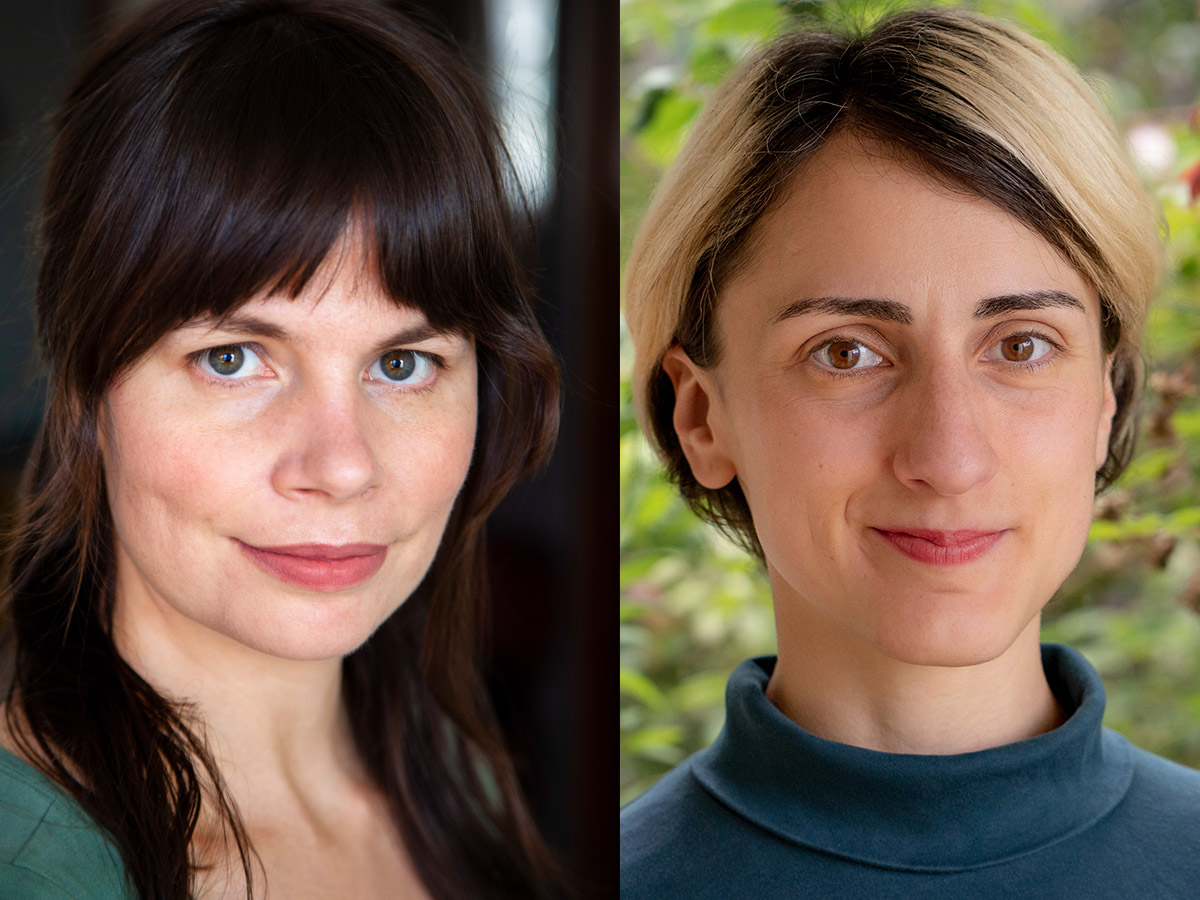 Editors Erin Casper and Jocelyne Chaput
Editors Erin Casper and Jocelyne Chaput
CASPER: The question of how to acknowledge their passing was one of the big picture items that we talked about from the very beginning of the process. We all came together for a weekend retreat after we had looked through the footage, read through their books, and looked through their interviews that we had at the time. We were actually receiving those throughout the process.
But we had a weekend where we didn't have our hands on the keyboard. We weren't editing, it was a moment to talk about the things that came up for us thematically, the questions that we had, the things that we loved and that we paid attention to. A big question was, "How do we acknowledge this and when do we acknowledge it?"
Like Jocelyne said, we had that first cut where we didn't say anything about them dying up front, but it was like having a ship without a rudder. It almost takes you away from being able to immerse yourself in the film because you don't know where it's going. It casts this lens by acknowledging it upfront. We're not really giving anything away. We felt that it colored everything that comes after it because it makes you think more about their choices that they made while they were alive and made you think about not how they died, but how they lived. We wanted it to be a celebration of the way that they chose to live their lives.
CHAPUT: It set the clock going as well. It suffuses everything with the extra tension and romanticism and gives it a bit more of an existential lens. It foregrounds the materiality of the archive a bit more. We were really interested in this idea of, "What do we leave behind once we go?"
In their case, they left behind something remarkable: Hundreds of hours of footage and their photographs. We wanted to celebrate that in a sense as well and call attention to it in a way. It's not something we ever explicitly state, but I think for all of us, we had a profound gratitude for archivists. It's such an important job and role in society. If we know they're gone, then we're not left with this question of maybe we're going to meet them or waiting for this reveal of, "Where are they now?" The other thing it does is it clarifies for us that we can just stay in the past. We're not going to jump ahead to 2020 or 2021 and show the present. We're going to just stay in the world of the archive. By doing so, we can make that feel more present tense because we're not jumping ahead.
CASPER: By acknowledging it upfront and acknowledging that this is what they left behind and that there are gaps in their story, we lay all of our cards as storytellers out on the table. I think that we gain credibility with the audience by saying we don't know everything, and this is a highly subjective story. But then also by saying Maurice and Katia have passed away, it justifies in a very subtle way the existence of the narrator.
This is someone, not the voice of God, but somebody who is taking us through the story because Maurice and Katia aren't here to do that themselves. It's a way of establishing those very important things up front, earning the trust of the audience, situating everybody so you know where we're going, and you know that you're in good hands.
CHAPUT: That decision just solved so many problems for us after the first edit and so many things clicked into place. It was one of those very consequential decisions we made as far as affecting the rest of the edit and how much better that decision made the subsequent edit.

CASPER: We wondered about that for a while. I think the linearities fell into place naturally because we knew where we had to end up. There's maybe one place where we step out of place linearly. But for the most part, it ended up that way organically.
There's sometimes a question when you're writing as you edit, "Oh, am I telling this story chronologically?" But I think for me, the only thing I care about is that there's a clear progression. If that's married to chronology, fine. But we weren't necessarily dead-set on it.
CHAPUT: There are also scenes that are not exactly taking place in one time. There are scenes that are a bit more meditative where we're borrowing from different periods of their lives or their footage to reflect on who they are or reflect on existential questions. Those scenes, while not linear or nonlinear, exist in a more timeless state. In the film, we did one jump back in time with the acid lake scene in order to explore the characters more. That was very much warranted by where we were at that point in the story.
Like Erin said, there's often this resistance, but at the end of the day, it is about two people who are learning more and more and making decisions along the way. They chose to go closer and closer and take more risks. So it made sense to track that in a more chronological way because it really does raise the tension to follow their own journey of understanding.
CASPER: Especially once we really narrowed in on that perspective, it became the organizing principle which we ultimately structured the film. There were other times where we included more about their rise in notoriety and their success. Some of those expeditions that led to that are fascinating and scenes that we all love and really miss.
But it's just not about the "rise to fame" story at all. It's really about, as Jocelyne said, their love story. Their version of love is really trying to understand. The more they want to understand, the more they go toward. That really informed where we went in any given scene and sequence.
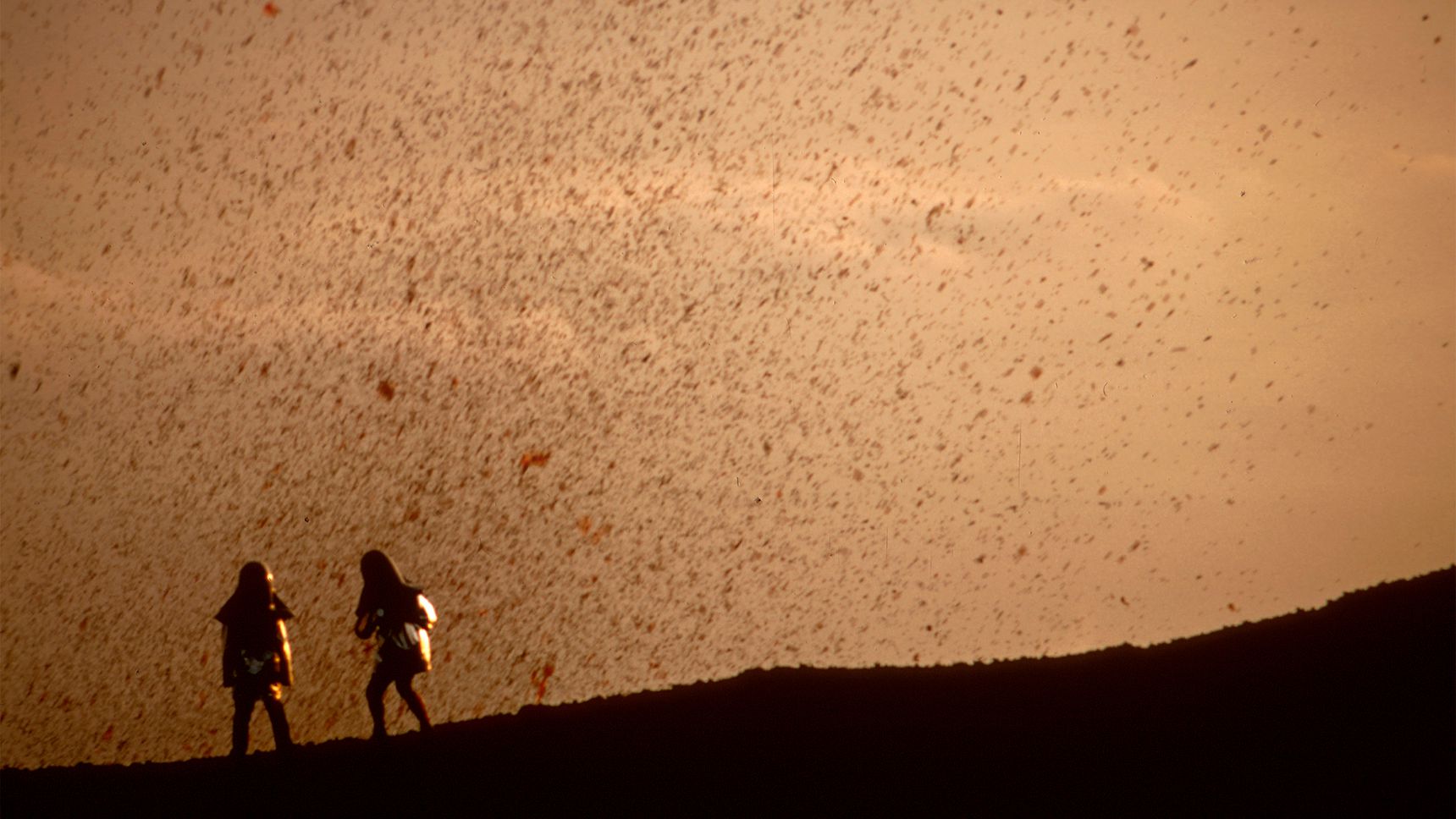
CASPER: It didn't really fit. To be honest, it was the hardest section of the film to nail down. It really danced around all over the cut and I think it’s the reason why it ended up where it did: in a sequence that we refer to as “the elbow.” Not for any real, rational reason, it's just this weird bend in this story in what feels like a little bit of a timeout after this clear rise in confidence with Maurice and Katia. Then we're trying to get to the turning point where they miss the Mount St. Helens explosion and then decide to study gray volcanoes and focus singularly on that.
There is this section where we start to set the stage for them transitioning away from red volcanoes to gray volcanoes. The acid lake scene reflects their ennui and complacency with where they're at in this point of their career. They're established, they're home, there are the doldrums of planning for these expeditions and making money so they can keep going out.
It's playful but also a serious fray for Maurice and Katia as well in terms of the way that they see risk and how they approach it. There's a lot happening here. But then also it's a way in which we start to really address how they are thinking about inscribing themselves in their own myth and thinking about their legacy. That was one of those stories that Maurice told on talk shows for the next 20 years. That playful way of telling these stories gives a way to larger thoughts that come into play toward the end where they're really thinking about their lives and their legacy.
CHAPUT: We had a hard time finding the right place for that scene. We love the scene. It's so absurd and comical in a way. Your palms sweat at the thought of going on an acid lake and it's such an excellent illustration of their personalities. We weren't sure where to place it because it does technically take place in the past. But we connected it because at that point in the story, Maurice is obsessed with this idea of a lava canoe.
He wants to ride a lava flow, but he never did that. The acid lake story was almost a way to explore that kind of madness of Maurice and his seeming obsession with just being that close to something so dangerous. In both cases, there's the idea of going on a boat. In the story, the present tense is that he wants to go down a lava flow. We took that idea of going in a boat and that allowed us to leap back in time into this other boating idea. I found it satisfying to be able to go back in time in the name of further exploring something that we've established in the present tense of the story. When I see the acid lake scene, I'm thinking about this lava canoe idea and realizing that, he really would do it.
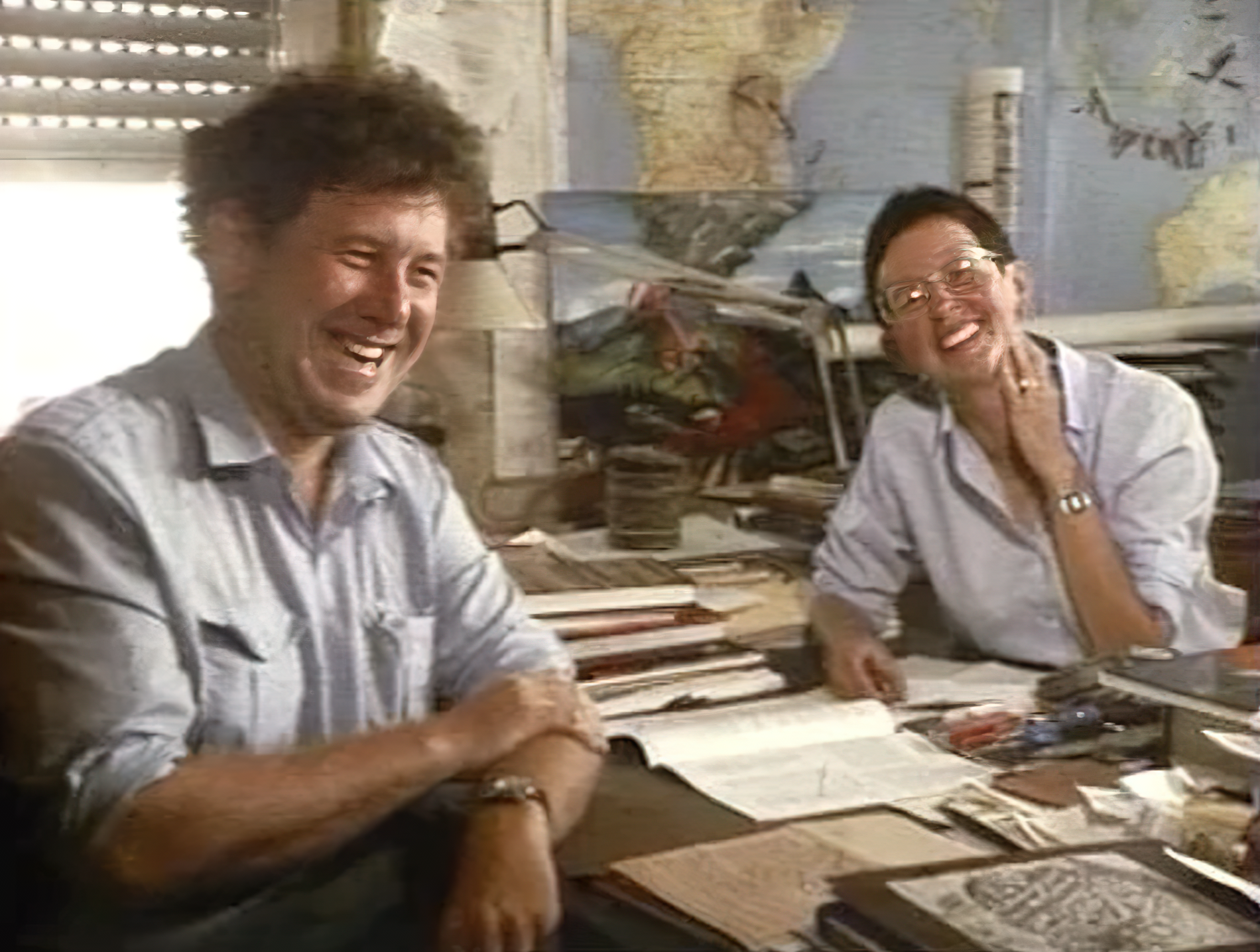
He's already gone on the acid lake; he's not even joking. But at the same time, we've all debated how serious he was. Director Sara Dosa met Bertrand, Maurice's brother, and he chuckled and said, "Oh no, he wouldn't have done it." But then other friends of the Kraffts' said, "No, he was very serious."
CASPER: One of their close collaborators claimed that it was a little bit of both. I think this is maybe my own sort of idea on this debate, that given half a chance, if he had been gifted the Gemini space shuttle capsule from NASA, he would've in a heartbeat. It was a real project that he worked on from time to time between expedition phases. Maybe it was just one of those fun things to dream about. I think that part of him enjoyed getting a rise out of Katia about it.
Sara conducted numerous background interviews with friends, family, and colleagues of Maurice and Katia that informed the narration. She talked to one colleague who worked with them in the later years, a woman named Leanne Wiberg. She became close to Katia during that time and remembers Katia confiding in her about the lava canoe and how that was actually a bargaining chip for Maurice in studying gray volcanoes. Whether or not it was a serious thing, it was serious enough to reorient themselves in their study and their pursuit toward gray volcanoes
Did you do a wall of storyboards? Did you analyze structure and story that way? Or was it more just talking and thinking it in your head? Or was it in the timeline of the Avid?CHAPUT: All of the above. A lot of Google Docs.
CASPER: We all live in different cities. I live in New York, and Sara and Jocelyne live in Berkeley, though Sara's fairly nomadic. We were also making this film during the height of COVID and really weren't able to safely work in person and travel pre-vaccine. So we were trying our best to work remotely for a while. We had Google Docs, but then once we were able to move around a little bit easier, we moved in with Sara. We still had Google Docs, we had in-person conversations, we had all of our funny scene names on dry erase boards.
CHAPUT: It really depends on what you're grappling with that day. Do we need to take a step back and look at everything at one glance on the wall? Or do we need to get into the nitty gritty of each scene? You can do that more efficiently in a Word document or Google Doc because you can include more information in those digital outlines. We also had threads text threads-
CASPER: Slack channels.
CHAPUT: You name it, we had it.
I love the idea that you said that you had your funny scene names. What are some of the names you had for scenes?CASPER: We do have a photo somewhere. There's "Sexy Time," "Robot Dance Party." One of my favorites is "Placeholder," because we have just so many scenes, so it was a placeholder. We had those for a long time.
CHAPUT: We had "Existential One," "Existential Two."
CASPER: "Belle Chose" that has nothing to do with anything that's in a scene. Oh no, Maurice does say one line, "Belle Chose."
CHAPUT: "Lava Tube Creepy Cave." I think there was one scene called, "We Know Nothing." Which was existential, or maybe that was us just remarking ourselves.
 Best Scene Names Commemorative White Board for "Fire of Love"
I love all of those. That's pretty funny. How does writing the documentary and editing the documentary combine? I'm specifically thinking about the narrator. Did you have the voice from the beginning? Did you temp narration?
Best Scene Names Commemorative White Board for "Fire of Love"
I love all of those. That's pretty funny. How does writing the documentary and editing the documentary combine? I'm specifically thinking about the narrator. Did you have the voice from the beginning? Did you temp narration?
CHAPUT: The writing process was super collaborative. Once we knew we wanted a narrator, one of the first steps for us was to ask, "Okay, well, what's this voice? Who are they?" We actually wrote a long backstory for the narrator. None of those details are in the film, but it was a means for us to really arrive at a voice and to really start figuring out what the narrator would and wouldn't say.
We eventually arrived at this confidence of knowing who this narrator was, even though we didn't exactly have an image in mind. We really didn't want a Voice of God, so that was one of the first major decisions. It's just we would like to embrace this theme of the unknown and of the gaps in the archive, really lay our cards on the table, and have a voice that also doesn't know it all.
CASPER: I think one of the most important things was in terms of approach. Maurice and Katia weren't the kind of scientists who had all the answers or even pretended to know the answers. I think that not having the answers was humbling to them in a way that they really kept coming back to. Maurice talked about it constantly. Always encountering different volcanoes and being out in the world, just constantly having his mind blown by what he's seeing and not understanding it. I think for them, that was an experience that they came back to over and over again.
So it just didn't make sense from the narrator's point of view to be more confident than our own characters. I think it was important to all of us to really embrace that uncertainty and not knowing anything. Because I think it's an invitation to the audience as well to wonder about how our world works and not be dictated by, not only from a scientific point of view, but from a philosophical point of view.
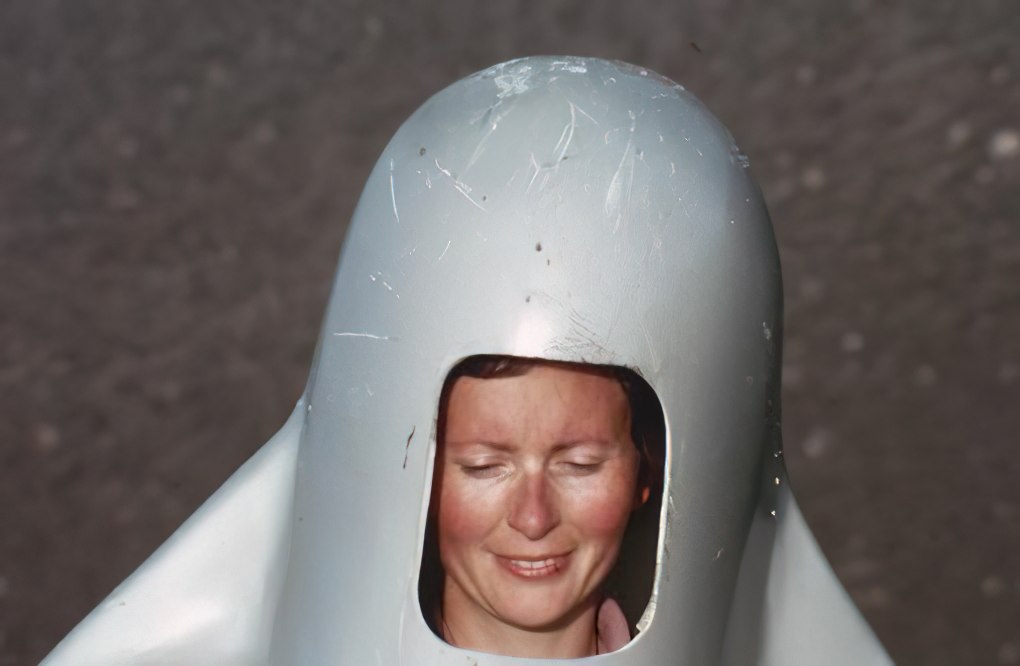
That is how we really tried to create their voice, that's one layer of writing. But then these really satisfying details throughout the edit were another layer, and I think this is where editing and writing overlaps. Documentary editing is writing, but specifically how it overlaps with writing narration is that we were always wondering, not having the context from Maurice and Katia themselves. We're wondering about what they were pointing their cameras at and what scientific purpose it had.
The writing functioned on a really detailed level where it could connect your eye to what you were seeing and understanding. It's not just a beautiful image of lava, it's not wallpaper. You're understanding something new about volcanoes or about the earth. That was really hard-won and very satisfying, both for us and also in terms of telling the story.
CHAPUT: As far as how we were actually working with the narration, whether we were writing first or editing first, it really depended on the scene. But I think more often than not the writing was happening at the same time. We did this hand motion a lot. (she gestures with her hands as if tuning two big dials at once)
CASPER: It's like calibrating between one dial on one side and a dial on the other side: the writing and the edit. We had to do it at the same time. It was like walking across a bridge that you were building at the same time, one plank at a time.

CHAPUT: Sara, who was very much embedded in the edit, wasn't editing the pictures herself. When she wanted to send us ideas, her ideas would often be very, very developed and would come to us on paper. We would receive a first draft of a scene from Sara. In that case it's, "Okay, we have the words." Then we take that, we run with it, then we discover more ideas in the footage, and then talk to Sara and pitch our ideas.
Again, the calibration happens collaboratively where we're telling her what we're finding and where we could go with this. Then she's revising her writing accordingly. So it's not only us as individuals doing that as we work, but it's also chatting with each other. So once we had our lines, we recorded temp narration until Miranda July (the narrator) came on board at the end. That was a fun process as well.
CASPER: It was a little mishmash at first. Jocelyne and I overlap in complementary ways, but also different sometimes. You were more, "I'll just put in scratch voice over," and I would, but we kind of had this weird blend of our voices for a little bit. Then sometimes I would put in text on screen. I would try to time it, but it's just not the same as hearing it and we're really trying to approximate it as much as possible.
But Jocelyne really became our OG narrator. It was actually fantastic because these were cuts that we were sending to Sundance and to all these festivals around the world and being accepted. We thought a lot about the narrator throughout the process. It was again a collaborative effort on that front too. We were obviously thinking of someone French to begin with, all kinds of ideas. Then one of our executive producers, Greg Boustead at Sandbox Films, asked one day, "What about Miranda July?" Collectively, we all said, "Oh!" It was like a lightning bolt moment where it really felt like everything we had been writing just really found its home.
CHAPUT: We love her. She's an artist that we've all admired for years. She works in so many mediums and just has this deep, profound curiosity and way of expressing the precarity of life and of relationships and the weirdness that comes with being alive. I highly recommend her work, her writing.
One of the things that struck me: the whole group was writing without knowing who that voice would be. Did things have to change once you had a narrator?CASPER: Not really, no. I'm sure it would've changed things to some extent to know our narrator from the start. I think it was just one of those things where it was this perfect match. I don't think it could have happened any other way because to have someone that would've necessitated any kind of rewriting would've been a massive undoing. The film is so carefully constructed that any kind of change like that would've meant re-editing the film completely.
CHAPUT: We had confidence in our sense of who this narrator was. Even though we didn't have the final voice we very much knew that these are the words and we had that backstory. We really had a sense of who this voice was. It was such a fantastic moment of being pitched Miranda and realizing all along that she's perfect. She's exactly the kind of person that we've been looking for that we didn't know until that moment. She brought so much range and warmth to the delivery and we really lucked out with her.
CASPER: She did have big shoes to fill with Jocelyne's narration. Her voice set the tone in a way where it was like this kind of deadpan curiosity.
CHAPUT: But a romantic at heart. Someone whose romantic side is still just about to bloom or is blooming across the span of the film, perhaps…
CASPER: …who's looking at these archives and thinking about these people and asking questions.
CHAPUT: We're starting to go into the backstory.
As an audience member, I felt like the narrator was actually a friend of the Kraffts.CASPER: I love that you picked up on it. That was important to us. Maybe not someone that the narrator knew, but felt like Maurice and Katia were friends. That there was maybe like a longing, but also intimacy. Even a form of Sara's direction for Miranda, a warmth towards the two of them. That's very satisfying to hear that because that was something we talked about a lot.
Oftentimes, in documentary editing, you're trying to illustrate something that can't be illustrated. You've got these two people that, of course, you have images of the two of them, but you used the analogy of two coffee cups to show their relationship. Can you talk to me about discovering that idea and then using it in several places in the documentary?CHAPUT: That was Sara's analogy. We looked at French New Wave films a lot, and we were thinking a lot about that period of time. Especially because they met in the sixties. It was France with cafes all over the place. Of course, we took our cues from what we knew about them or what we might know about them.
There were different versions of how they met. One of the stories we heard is that they met at a coffee shop. While we didn't have original footage of them when they met, there were ways of invoking that and ways of constructing or setting the stage visually. We dug around other archives. France has a fantastic archival portal called INA.fr. You can find so many pieces of archival footage that have been digitized. We were able to go and find clips of cafes from the sixties and really reconstruct this one version of how they met. We borrowed a few clips of them on television shows in the sixties from their own footage and we could kind of make it look as though they were sitting in a cafe.
I think that sequence is very much inspired by the French New Wave. We filmed the shot of those coffee cups with a fantastic cinematographer, Pablo Alvarez, who shot on a Bolex camera. Those two coffee cups that you see are one of the few shots that we filmed to fill in that particular gap.
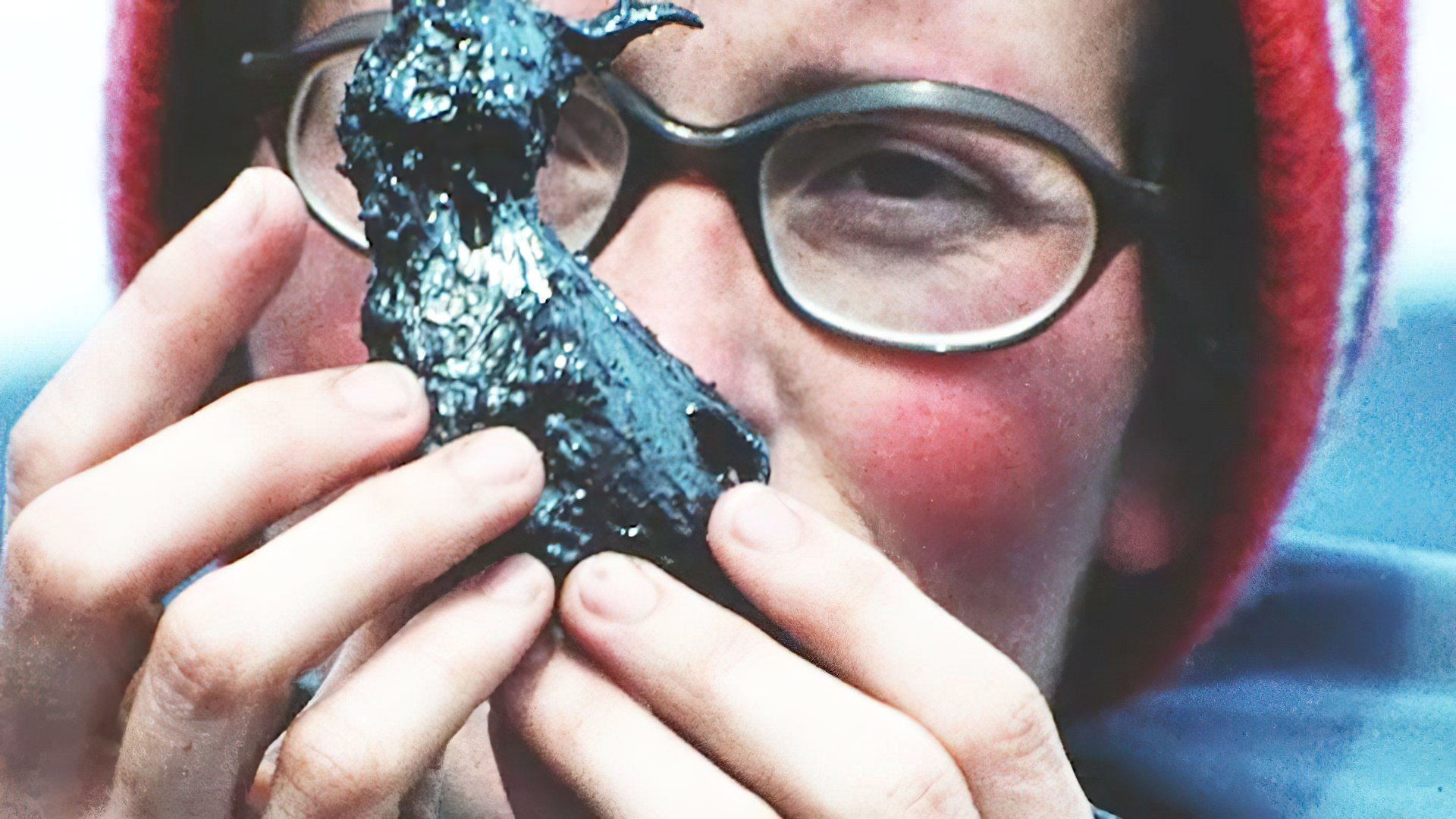
CASPER: The other thing too is how and when to address Maurice and Katia's deaths. This is a film about telling a love story and telling their love story in particular. How do you show them falling in love? That was another big question that we discussed over our initial meeting. They're hardly on camera together. How are we going to tell this love story? It's just one of those things where you look at what you have. We decided to just show our hand our cards and say through our narrator, "This is from Maurice and Katia, this is the material that they left behind. We don't have everything to perfectly illustrate their story." But by doing that, it opens up this playfulness to tell the story. We're not trying to hide it by pretending we have footage of them. We're going to be playful and illustrate it in different ways. I think just by doing that you get the audience on board even more.
CHAPUT: For the coffee cups, it was a way to recreate a scene that we didn't have but could still allude to romance by having the cups come closer together over the course of that scene. Little things like that. As we edited, we really developed other means of expressing love and romance in a figurative way. Instead of the obvious way of kissing or holding hands paired with a big, swoony ballad. You can really get across a lot without even showing it.
CASPER: Power of inference.
CHAPUT: Power of inference, exactly. That was really such a joyful part of this process, really developing that love language so to speak. Another way we did that was with animation. We worked with a wonderful animator, Lucy Munger, and her work filled these gaps for us where there was really no other way to visually explore certain facets of the story. In particular, them falling in love.

CASPER: All of the above. That was really another highly collaborative aspect of this process. We would have moments where maybe this is appropriate for animation. I think just to have something to work with, we would start putting in the sound effects and timing and the music. Then we would put placeholders describing the shot more or less. We did that in conjunction with Sara fleshing out the idea of what the narration is, what the action is, timing it, and then sending these excerpts to Lucy, who along with Sara and our associate producer, Elijah Stevens, were doing image research and finding source images to pull into the animation.
Then Lucy, as I understand it, would print out these images, create paper cutouts, and then do stop motion animation on a scanner flatbed one frame at a time. Those placeholder timings became really important to get right and approximate pretty precisely before sending it off to Sara.
CHAPUT: I think music helped with that narration. Everything else, like the sound, would be all placed and would really give us a sense of the exact timing right down to the frame.
CASPER: Sometimes Lucy needed some extra time or she'd ask, "What do you think about adding like a little bit of a breath here?" Because we really edited the film down to the frame. The way that everything interacts with each other, the sound and the image, are very playful. We would adjust on our end, send a new reference back to Lucy, and then she would adjust. It was really collaborative in that way as well.
Talk to me about building some of those montages and how you determine how long they're going to go since many aren’t paced by narration or dialogue.CASPER: I think it's just a feel thing. Something that I love about montage is that you can say so much without having to say a lot and explore an idea emotionally or like a behavior. Sometimes honestly, it's just, "How much song do I need or do I have?" Or just trying to say something and not overstay our welcome or even just have a breath in the film.
CHAPUT: I think a montage has an arc. In my experience, it doesn't take much for one part of it to drag if you try to put in too much. Of course, with this archive, it was so tempting to just go on and on because we had an embarrassment of riches. The shots we had to work with and agonizing over which one to use, that happened all the time. The imagery we would find was consistently remarkable.
In moments of weakness, it was tempting to just roll the entire song and just say, "Let's just do a five-minute, full song montage here." But once you're thinking about the story again and the propulsion of the story, the flow, and the arc within the montage, what are we doing with the storytelling? Even though it's music and there's no dialogue, there's still progression. You really sense when things need to continue moving along. You do want a montage that has music. But you want to go into it at the right point in the song and then you want to leave it at the right point in the song as well.
That's a great place to leave this. Thank you so much for your time, ladies. It was really enlightening to hear about your approach to this documentary. Good luck at the ACE Eddies and all the other things you guys are up for.CASPER: Thank you so much. It was a pleasure!
CHAPUT: Thank you, this was fun!


